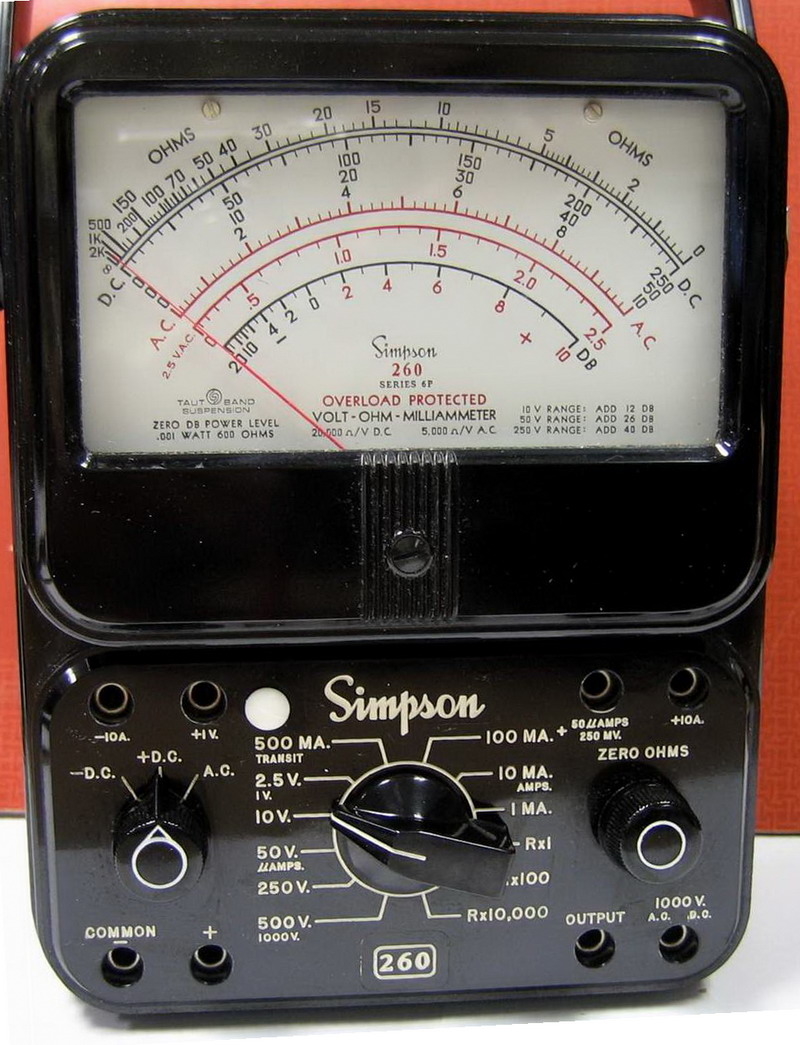-
Posts
846 -
Joined
-
Last visited
-
Days Won
26
Content Type
Profiles
Forums
Gallery
Store
Everything posted by jonathan909
-
I have plenty of experience with trouble from ground loops and very small circulating (as in electrical, not liquid) currents, so I get what you're talking about. What's important is that these problems are almost always solved by selectively removing excess grounds, and never by tossing in a bunch of extra new ones without very carefully analyzing the problem, or you can often make it worse. More grounds means more possible paths for those circulating and stray currents, and in this case adding a location (i.e. the rad) for possible electrolysis and/or corrosion that didn't previously exist. In other words, let the rad float (electrically speaking) and it won't give you trouble, even if it is a few millivolts away from the engine. (If there are any vintage microcomputer geeks listening, a formative experience for me in solving this kind of thing was about 40 years ago, working with a client who was building an early GIS system - it had to do with potential oil spills. Their system had outgrown the original (10-slot S-100) North Star Horizon chassis thanks to a whack of Matrox graphic cards. So I migrated them into a big rackmount (22-slot) Cromemco Z2-D box, which also meant duplicating in wire-wrap the serial and parallel I/O that were on the Horizon's motherboard (unusual at the time, as most S-100 backplanes had no active circuitry other than (perhaps) termination). They needed a hard disk, and this being a few years prior to the introduction of the very first (Shugart) 5meg 5" Winchester, we were using a 15meg 8" drive - a Priam or something. That's the part that was giving them trouble - the disk just wouldn't settle down and behave reliably. Disk read amplifiers are quite sensitive to noise, and I traced the cause to a couple too many grounds in the disk system that had been added and/or neglected by the North Star designers. Once I'd had some time to stare at the whole picture, I took a reasonable guess at which grounds had to go, and when I removed them the noise disappeared and the system sprang to life - and gave them years of pretty impressive service.) So I'm still skeptical, but might be convinced if someone can direct me to any solid references on the subject describing this application.
-
I don't want to get into the weeds on this, but I'm not buying it. Lots of things get "mentioned" that are complete nonsense. The coolant is constantly circulating through the engine, so I think it's succeeding in keeping itself pretty damn grounded wrt the engine, regardless of whether the rad core is insulated from the chassis. I'd need to hear a pretty convincing argument to think otherwise.
-
Rad: Fried by what? Rads aren't electrical any more than the hose running to your lawn sprinkler is. Yeah, you'll want to look seriously at wiring e.g. the ground you describe. [edit] And don't ignore the possibility that you could have a bad keyswitch. It's a single point of failure for the entire electrical system.
-
First of all, what the hell does a rad need grounds for? I get where you mean, but they're scattered elsewhere as well, e.g. on the shock towers (aren't they the two bolt heads I see peeking up there over the rim of the stamping? My '99 OBW has a couple there, on both sides.). But that CEL flash and the brief drop in revs? I'd be thinking bad ECU, maybe bad power. Investigate your relay box.
-
Man, something that random is going to be a b@st@rd to debug. I know this is a mantra, but there's a lot of truth to it: Bad grounds. Hunt them down and make sure they're all sound. Bad connectors - but you had the engine out and back in, so you've cycled a lot of them and they should be making good contact. You have a new alternator, so your power should be solid. Maybe a flaky ECU? Is the misbehaviour isolated to the engine, or are there any other peripheral symptoms?
-
Fair enough. As far as repairing the motor goes, it's pretty much like any DC motor, so both the brushes and commutator are going to wear and get dirty. So maybe it just needs a cleaning and a new set of brushes, but maybe the wear to the commutator is such that it has to be replaced, and then you're futzing with the windings, so this is all stuff best left to shops that specialize in... wait for it... motor rewinding. Sure, they used to do more of it here, but now it's a more disposable globalized society that doesn't want to pay North American rates for that kind of service, so "Mexico". While I'm certain you can find someone locally who does that, I doubt you're going to want to pay them some multiple of the cost of a new starter. Just how it is.
-
Well, I finally got the miserable sumbitch out of there... in the end it was the predicted "brute force and ignorance" So I've been busy today transplanting the necessary bits between old and new tank, repairing hacked wiring, and finally checking those two valves: The fuel cut valve and the vent valve. They're in the top rear of the tank, behind the seats and without access panels. So nothing's happening to them without dropping the tank, and I'd better get it right this time. The cut valve is easy to check: It's just a float, so poking from beneath or just inverting it closes it. Simple enough. The vent valve is harder. To quote the FSM: When the fuel vapor pressure becomes higher than the atmospheric pressure and overcomes the spring force which is applied to the back side of the diaphragm, the port toward the canister is opened . The vent valve also has a float which blocks the fuel vapor passage when the tank is filled up. Increasing fuel level raises the float to close the port toward the canister. So it responds to both tank pressure and fluid level. How the &@!! do I check this? I've got two of them, and they seem to behave the same ways when I suck+blow the external ports (not tryin' with the in-the-tank portion), so do I call that "good enough" and put it together?
-
Yeah, I've always assumed it was a dodgy commutator when it did the intermittent-a-little-worse-when-cold thing - you're actually spinning a roulette wheel and instead of red+black it's landing on start and no-start, then the temperature just adds a dollop of chaos. So I replace it with a boneyard pull and don't wongleflute ("wongleflute"? What I really meant was "kerfspluddle".) around with rebuilding.
-
Sure, it could be the keyswitch. A (mechanical) switch is a switch is a switch, and the contacts can go bad like any other. Actually, I was a little surprised that you did the starter rebuild rather than just replacing it, since (iIrc) you indicated you have a nearby pick+pull yard. I've experienced exactly that rest/temperature sensitivity in starters, and I solved it with replacement, not a rebuild. As for the security system, I should be the one to answer that, since (as I mentioned in the other thread) I kinda went overboard a couple of years ago in an effort to understand the Alpine remote entry system used from '98-'04 (or whatever it was). The security module is a second little black box that communicates with the remote entry module. I built a jig for testing and messing with them (both parts), but to be honest didn't play much with the security module, since I don't care about it - I was mainly interested in being able to reliably program the remote entry system (that is, to register the fobs to it), and there's been a long-standing question of why that programming stops working in these old cars. To disable the security module (if you have one) you just unplug it. It's usually found under the hand brake trim. But that doesn't answer the relay question, and I honestly don't remember that part. Will have to consult the drawings. This is where the question comes full circle - my conclusion on the fob programming problem was that it stems from wear in the keyswitch. But that's just a point of interest. My guess is that your starter is just being a persistent PITA.
-
Finally took the '01 Forester out for a proper spin, first since the bearings+rings job. I haven't fully characterized it yet, but it was pretty damn cranky. Idle-hunting, stalling, surgy when accelerating at low speed and revs, etc. Finally popped the "too rich" error - along with 3 misfires, which are clearly the effect of the former. Fwiw, the dash temperature reading was normal. Now, I get that this is a closed-loop control system, and I'm pretty good with those - I just need a back-of-the-napkin sketch of what the relevant inputs and outputs are, and a little on the nature of the transfer function. Can anyone direct me to something reasonable and succinct and understandable to the slightly dense reader? Worth mentioning that it was running fine before the teardown and nothing was replaced other than some bad pieces of metal, so it wouldn't surprise me at all for the odd slightly crappy connector/connection to be implicated.
-
They built a lot of variations on this one - I think some had mirrored scales, but probably the same meter movement. Right about the needle movement - that's what I've been alluding to in this thread. Even regular, low frequency (think 1Hz or less) periodic functions, whether sine, square, triangle, sawtooth. With an analog meter you see immediately what's happening. Digital: Just a lot of wild numbers bouncing around. Of course, lots of DVMs have the little bargraph down below to help, but it's not the same. A few years back I banged together a little CO2 controller for grow rooms - modern CO2 sensor with an analog output fed into an AVR to run the CO2 generator, room ventilation, etc. On the first pass I put a digital display on it for the ppm reading, but then built a second rev with a nice big analog meter instead, kinda just for fun. I tell you, even I was surprised at not only how much faster and easier to read it was, but also at its retro/sexy/cool vibe.
-
Dude, exactly. Up here, though, it was more often a Simpson 260 - though I'm kind of stunned to see the prices associated with these things now. A few years back I bought a crate of 'em for twenty bucks through a rather odd surplus->thrift store channel. This is the type of meter I'd recommend to our friend here, because you can really see what's going on. Even for hardcore electronics pros, what you get on a DVM can sometimes be very confusing. And autoranging.... Don't get me started on autoranging...
-
Yeah, probes are a whole thing. For many years my preferred probes have been the extendable needle point probes made by Huntron: https://www.jensentools.com/huntron-98-0078-mp10-microprobes/p/447me109 Fluke used to sell them as well, but not anymore, afaIk, which is a shame. They may have replaced them with a version of their own. Huntron's stuff (at least, their early products like the "Tracker") was bogus, attempts to bring troubleshooting to people who don't understand what they're doing. Yet another friend a long time back called it "the new charlatanism". But those probes were and are brilliant, only one of their features being that because they're so slim, you can easily handle them exactly like chopsticks. The only thing that's not perfect about them is that they're relatively fragile - they're not made of a flexible/resilient plastic like most probes, and if you step on one it's a goner. I've never actually fired anyone for allowing one to sit on the ground, but I have issued "the only warning you will get for this" a few times.
-
Sure. I've never noticed it myself, but I guess you can get some inductive (like a transformer) and capacitive coupling between the two wires, and how much would depend on how long the run is. But you probably wouldn't be able to measure much between the two because there'd be little phase difference.
-
Oh - and after all that, if you STILL have doubts about my knowing what I'm talking about, next time you're in the neighborhood of New Kensington - about 3 hours from you, according to google maps - you can pay a visit to a working computer museum another friend of mine runs there (and I'm talking about big vintage iron - mostly DEC - not little crap like VIC-20s), and I'm sure he can straighten you out. PM me for the location details.
-
I don't want to beat this to death, but you should understand that you're trying to give basic electricity lessons to an EE who's been in the field for more than 40 years. You might get a little sense of my background if you search some of my old postings, particularly the thread about figuring out why it's so hard to get the Alpine remote lock fobs to sync with old cars (I went a little crazy with that one, to the amusement of some here). To your points: You don't have to be naked to not be carrying any static charge. As soon as you touch the car you're bleeding it off. And you'd be amazed at how little dielectric strength (that's "insulating power" to you) most shoes offer, whether you're handling a defective power tool or getting struck by lightning. As for your second lesson, please donate your DVM to someone in need, because it's just confusing you unnecessarily. You should instead be using an old-school analog-movement VOM, because it'll give you nice, solid, accurate readings for all the things that matter in the car (short of digital communication channels e.g. between the ECU and TCU, for which you need oscilloscopes, logic/protocol analyzers, etc.), and you won't have the DVM's dancing digits making you believe that things you saw once in a youtube instructional video matter when they don't. In closing, I don't like to brag, but you're kind of needling me into it. This picture is of the discharge electrode of a Tesla coil (built by a good friend of mine in the Bay Area). The electrode is 2 meters in diameter, and on top of the coil's secondary, 10 meters in the air. I am standing inside the electrode (not just for fun, either, though there was a lot of that - I was up there taking measurements), and together we are at a potential of approximately 1.5 megavolts. If anyone ever asks whether Faraday cages really work, this is what you show them. Now, since I've shown you that I'm reasonably well acquainted with both big volts at high frequencies and little volts at DC, was there anything else you think I need a little brushing up on?





